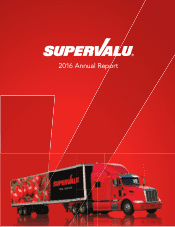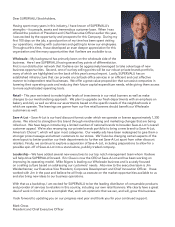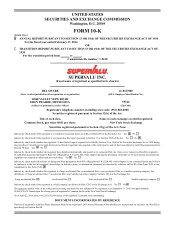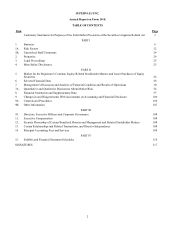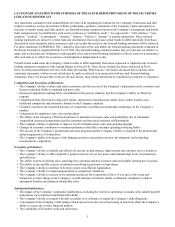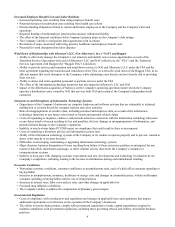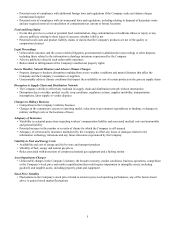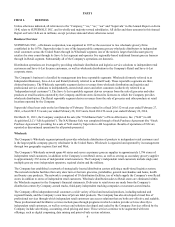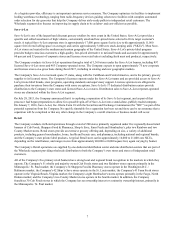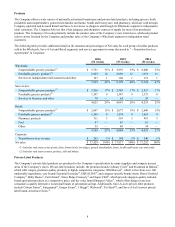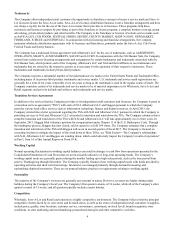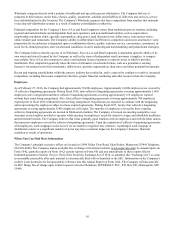Albertsons 2016 Annual Report Download - page 9
Download and view the complete annual report
Please find page 9 of the 2016 Albertsons annual report below. You can navigate through the pages in the report by either clicking on the pages listed below, or by using the keyword search tool below to find specific information within the annual report.
7
As a logistics provider, efficiency is an important customer service measure. The Company optimizes its facilities to implement
leading warehouse technology, ranging from radio-frequency devices guiding selectors to facilities with complete automated
order selection for dry groceries that help the Company deliver aisle-ready pallets to independent retail customers. The
Wholesale segment also focuses on improving its supply chain to be as labor- and cost-efficient as possible.
Save-A-Lot
Save-A-Lot is one of the largest hard discount grocery retailers by store count in the United States. Save-A-Lot provides a
specific and edited assortment of high volume, conveniently sized and low-priced items selected to fit its target customer's
needs. A typical Save-A-Lot corporate store is approximately 17,000 gross square feet in size (with approximately 11,000
square feet of retail selling space on average) and carries approximately 3,000 core stock-keeping units ("SKUs"). Most Save-
A-Lot stores are located in the southern and eastern geography of the United States. Save-A-Lot's private-label program
provides budget conscious customers a high-quality, low-priced alternative to national brands and accounts for approximately
60 percent and 55 percent of corporate stores and licensee store retail sales (excluding fresh meat and produce), respectively.
The Company conducts its Save-A-Lot operations through a total of 1,360 stores under the Save-A-Lot banner, including 897
licensed Save-A-Lot stores and 463 Company-operated stores. The Company expects to open approximately 75 new corporate
and licensee stores on a gross basis during fiscal 2017, including in existing and new geographic markets.
The Company's Save-A-Lot network spans 37 states, along with the Caribbean and Central America, and is the primary grocery
supplier to its licensed stores. The Company's licensees operate under the Save-A-Lot name and are provided access to Save-A-
Lot's private-label brands, store programs, operating standards and supervisory support. Licensee operators are obligated to
purchase their inventory from the Company with some exceptions. Save-A-Lot's 17 dedicated distribution centers provide
distribution to the Company’s own stores and licensed Save-A-Lot stores. Distribution sales to Save-A-Lot corporate-operated
stores are eliminated within the Save-A-Lot segment.
On July 28, 2015, the Company announced that it is exploring a separation of its Save-A-Lot segment, and as part of that
process it had begun preparations to allow for a possible spin-off of Save-A-Lot into a stand-alone, publicly traded company.
On January 7, 2016, Save-A-Lot, Inc. filed a Form 10 with the Securities and Exchange Commission (the “SEC”) as part of the
potential separation from the Company. No specific timetable for a separation has been set and there can be no assurance that a
separation will be completed or that any other change in the Company’s overall structure or business model will occur.
Retail
The Company conducts its Retail operations through a total of 200 stores primarily organized under five regionally-based retail
banners of Cub Foods, Shoppers Food & Pharmacy, Shop 'n Save, Farm Fresh and Hornbacher’s, plus two Rainbow and two
County Market stores. Retail stores provide an extensive grocery offering and, depending on size, a variety of additional
products, including general merchandise, home, health and beauty care, and pharmacy, including national and regional brands,
and the Company’s own private label products. A typical Retail store carries approximately 14,000 to 21,000 core SKUs,
depending on the retail banner, and ranges in size from approximately 40,000 to 60,000 square feet, again varying by banner.
The Company’s Retail operations are supplied by one dedicated distribution center and nine distribution centers that are part of
the Wholesale segment providing wholesale distribution to both the Company’s own stores and stores of independent retail
customers.
All of the Company's five primary retail banners have strong local and regional brand recognition in the markets in which they
operate. The Company's 51 wholly and majority owned Cub Foods stores and two Rainbow stores operate primarily in the
Minneapolis / St. Paul market; the Company's 54 Shoppers Food & Pharmacy stores operate in the Washington D.C. /
Baltimore market; the Company's 42 Shop 'n Save stores operate in the St. Louis market; the Company's 41 Farm Fresh stores
operate in the Virginia Beach, Virginia market; the Company's eight Hornbacher's stores operate primarily in the Fargo, North
Dakota market; and the Company's two County Market stores operate in the Seattle market. In addition, the Company
franchises 30 Cub Foods stores in which the Company has no ownership interest or a minority ownership interest, primarily in
the Minneapolis / St. Paul market.

